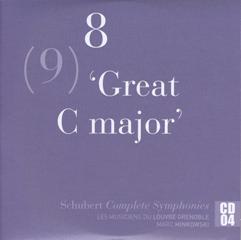Schubert - Symphonies CD4 (Minkowski) (2012)
Schubert - Symphonies CD4 (Minkowski) (2012)

Symphonie Nr.8 "Great C Major" 4-1 Andante - Allegro Ma Non Troppo - Piu Moto 16:45 4-2 Andante Con Moto 14:30 4-3 Scherzo. Allegro Vivace - Trio 11:55 4-4 Finale. Allegro Vivace 11:24 Bass Trombone – Guy Genestier Bassoon – David Douçot, Katalin Sebella, Tomasz Weselowski Clarinet – Ana Mello, Isaac Rodriguez, Robert Aigner Flute – Florian Cousin, Giulia Barbini, Jean Brégnac French Horn – Jeroen Billiet, Konstantin Timokhine, Takenori Nemoto, Yannick Maillet Leader, Violin – Thibault Noally Oboe – Andrea Helm, Emmanuel Laporte, Yann Miriel Timpani – Martin Piechotta Trombone – Nicolas Grassart, Yvelise Girard Trumpet – Serge Tizac, Thibaud Robinne Les Musiciens Du Louvre Marc Minkowski - conductor
This 4-CD set on period instruments sheds a new light on all the Symphonies, some not as highly considered as perhaps they should be.
Les Musiciens du Louvre Grenoble use instruments of the Classical era, laid out according to Viennese tradition, with the violins on either side of the conductor and the double basses in a line facing him. The oboe too is of Viennese manufacture: its highly idiosyncratic bore produces a sound, at once nasal and tender, that is immediately recognisable - indeed, despite developments in instrument making and the multiplication of keys, the modern version of this instrument is still not so very far removed from the oboe that Schubert knew. Four double basses are used in general but only two for the Fifth Symphony, which is written in a more central tessitura and dispenses with clarinets, trumpets, and timpani.
'In the 'Great C major', on the other hand,' explains Marc Minkowski, 'Schubert's ambitions recall, relatively speaking, those of Haydn in The Creation or Beethoven in the Ninth Symphony. That's why I chose to deploy five basses and to double the first flute and oboe parts and the second clarinet and bassoon parts: the use of three instruments per section allows us to obtain that organ sonority that was later to define the Bruckner rchestra, whereas the woodwind, in the early symphonies, sound like a pastoral group. When all is said and done, the key word for all this music is melancholy, even at the height of virtuosity - and goodness knows that these works, more ideal than practical, remain behind their apparent simplicity very risky to bring off in performance. Schubert wrote with genius for the orchestra, but his thought, much more than that of Mozart or Beethoven, was situated outside reality, in the tumultuous imagination of a young - sometimes very young - man, at the frontiers of the possible.' ---hmv.co.jp
download (mp3 @320 kbs):
yandex mediafire ulozto gett bayfiles
